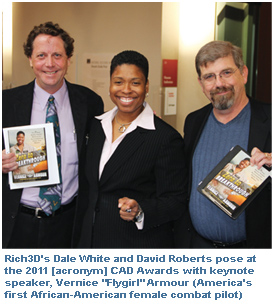
The U.S. Marine Corps and the U.S. Navy need highly interactive 3D tools to deliver complex animated virtual training and simulation environments for helicopter pilots, crane operators and other professionals. To respond to this need, government contractor Rich3D, uses a variety of 3D design tools from Autodesk, and a surprising to develop and deploy the interactive training environments they need. What’s surprising about this solution is that it was accomplished using a ubiquitous tool in the U.S. government, an Adobe Acrobat document.
As a result of its innovative design and service to the U.S. military, Rich3D was selected as a winner in the first-ever
[acronym] magzine public sector CAD awards, presented last November.
Recently, [acronym] spoke with Rich3D, about the company’s process and how it helps provide technology solutions for government clients.
[acronym]: What challenges or problems do you solve for your customers?
Rich3D: We tackle the creation of teaching tools where other methods don’t work or haven’t been created. Our customers have challenges where equipment is being destroyed, or where the use or tuning of equipment is very resource intensive. Our clients have asked us, "Is there a better way to teach this?”
In a recent project, for instance, the client’s challenge centered on aircraft technicians who needed to understand certain subtleties about how to properly pre-check the fuel system to load aviation fuel. Failing to trigger pre-check tests has the potential to overfill and burst helicopter fuel tanks, thus rendering the aircraft unworthy to fly. That’s an expensive thing to happen.
In another example, military field technicians didn’t always have a keen understanding of two sets of four levers used to manipulate an artillery rocket crane that uses an outrigger to balance and strong hydraulics to move the crane around. Field deployed artillery cranes were arriving on the backs of loaded trucks, then having their control panels sheared off by accidental misuse of the control levers, creating potentially big problems that might include having a load of rockets unavailable to be used immediately.
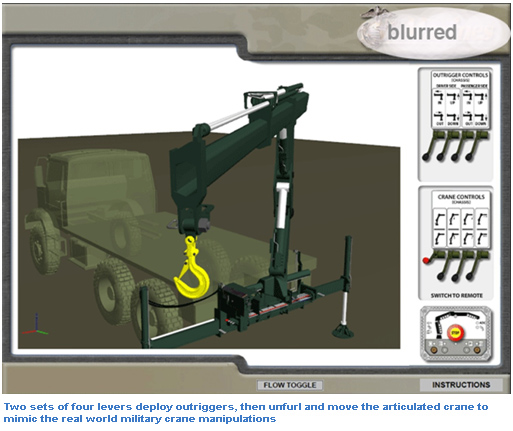 [acronym]: What kinds of solutions have you developed to address these challenges?
Rich3D:
[acronym]: What kinds of solutions have you developed to address these challenges?
Rich3D: In the first case, we replicated the entire fuel system and cockpit controls for the client’s specific military helicopter. Rich3D created a precisely measured, fully functional and totally virtual helicopter and fuel system. This tool allows service personnel to study, click, drag and adjust levers and buttons. The interactive experience helps develop a deep and testable understanding on manipulating the fuel system.
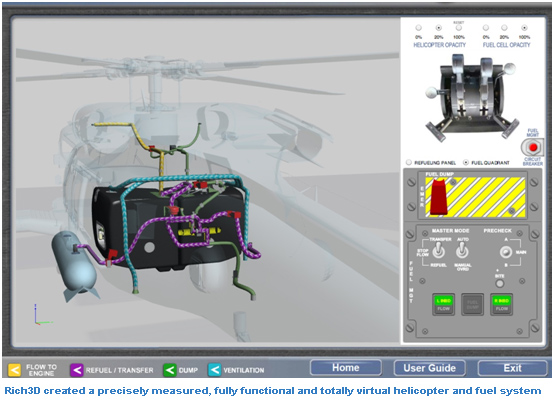
In the other example, Rich3D precisely replicated the artillery rocket crane, including all hydraulic tubing. The virtual crane is first stabilized by properly deploying the outriggers. It is then unfurled and moves. When movement rules are broken, then a message pops up. Teaching moments are presented precisely.
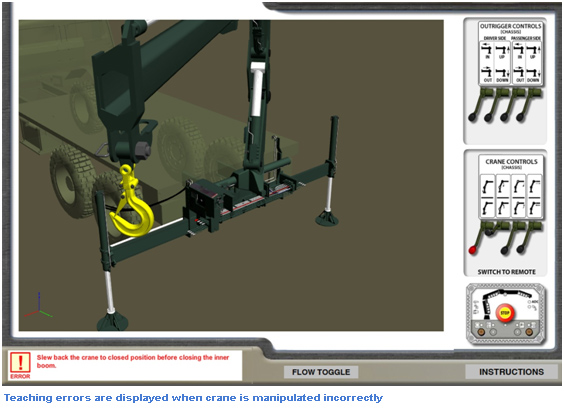
The training tools developed for these examples were ultimately delivered in an Adobe Acrobat PDF document. They were derived from Solidworks, AutoDesk 3DS Max, Right Hemisphere Deep Exploration, Adobe Flash and Photoshop, plus some math and logic. The PDFs weigh around 20mb and are fully self-contained with any proprietary coding password protected. The opened document features a stage on the left, which holds 3D content, while the screen area on the right has two-dimensional interactive controls. The controls respond and move with real-world logic and they manipulate objects on the stage.
[acronym]: How do your clients engage these solutions?
Rich3D: These carefully developed and military-approved PDFs arrive via small USB thumb drives, and are copied to onboard tough-book computers. They are opened just like any other PDF, and the stage is set. In the crane example I mentioned, the stage is rather clean, with only one set of levers, the crane folded into itself, and the outriggers also tight. Deploying the outriggers with the navigational levers offered causes more controls to be revealed.
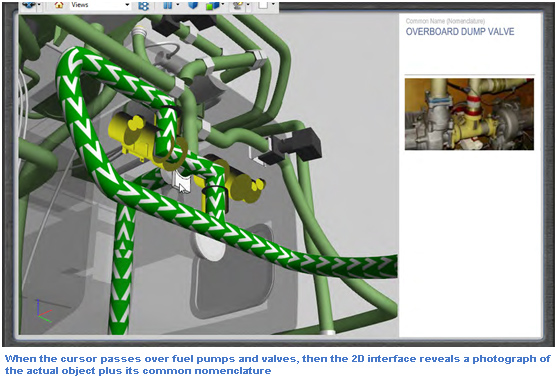
With the helicopter example, the opacity of the aircraft shell can be adjusted. Zooming in and pivoting to get a closer view of fuel pipes and tanks is easy. When the cursor passes over fuel pumps and valves, then the 2D interface reveals a photograph of the actual object plus its common nomenclature. When properly activated through the Fuel Management Control Panel buttons and switches, the fuel cells on the helicopter show the outer tanks filling first, then the inner tanks. During that period, the pre-check tests can occur.
[acronym]: What results have you gotten with these solutions?
Rich3D: We’re proud to report that both examples I mentioned have been approved and deployed to the field. Each of our client’s H60 Romeo helicopter flies with the Rich3D-built fuel system training tool. It’s now another tool to help keep that aircraft airworthy and an asset. The artillery crane is also used in the field as an effective training tool.
In addition, the artillery crane and helicopter fuel system learning tools do not cost anything to operate. Our solution consists of possibly the most complex Adobe PDFs developed, so it is easily portable but still very effective.
For more information about Rich3D, visit
www.Rich3D.com, email:
inquiries@Rich3D.com or phone 678-642-3023.
By Nancy Mann Jackson

 The U.S. Marine Corps and the U.S. Navy need highly interactive 3D tools to deliver complex animated virtual training and simulation environments for helicopter pilots, crane operators and other professionals. To respond to this need, government contractor Rich3D, uses a variety of 3D design tools from Autodesk, and a surprising to develop and deploy the interactive training environments they need. What’s surprising about this solution is that it was accomplished using a ubiquitous tool in the U.S. government, an Adobe Acrobat document.
As a result of its innovative design and service to the U.S. military, Rich3D was selected as a winner in the first-ever [acronym] magzine public sector CAD awards, presented last November.
Recently, [acronym] spoke with Rich3D, about the company’s process and how it helps provide technology solutions for government clients.
[acronym]: What challenges or problems do you solve for your customers?
Rich3D: We tackle the creation of teaching tools where other methods don’t work or haven’t been created. Our customers have challenges where equipment is being destroyed, or where the use or tuning of equipment is very resource intensive. Our clients have asked us, "Is there a better way to teach this?”
In a recent project, for instance, the client’s challenge centered on aircraft technicians who needed to understand certain subtleties about how to properly pre-check the fuel system to load aviation fuel. Failing to trigger pre-check tests has the potential to overfill and burst helicopter fuel tanks, thus rendering the aircraft unworthy to fly. That’s an expensive thing to happen.
In another example, military field technicians didn’t always have a keen understanding of two sets of four levers used to manipulate an artillery rocket crane that uses an outrigger to balance and strong hydraulics to move the crane around. Field deployed artillery cranes were arriving on the backs of loaded trucks, then having their control panels sheared off by accidental misuse of the control levers, creating potentially big problems that might include having a load of rockets unavailable to be used immediately.
The U.S. Marine Corps and the U.S. Navy need highly interactive 3D tools to deliver complex animated virtual training and simulation environments for helicopter pilots, crane operators and other professionals. To respond to this need, government contractor Rich3D, uses a variety of 3D design tools from Autodesk, and a surprising to develop and deploy the interactive training environments they need. What’s surprising about this solution is that it was accomplished using a ubiquitous tool in the U.S. government, an Adobe Acrobat document.
As a result of its innovative design and service to the U.S. military, Rich3D was selected as a winner in the first-ever [acronym] magzine public sector CAD awards, presented last November.
Recently, [acronym] spoke with Rich3D, about the company’s process and how it helps provide technology solutions for government clients.
[acronym]: What challenges or problems do you solve for your customers?
Rich3D: We tackle the creation of teaching tools where other methods don’t work or haven’t been created. Our customers have challenges where equipment is being destroyed, or where the use or tuning of equipment is very resource intensive. Our clients have asked us, "Is there a better way to teach this?”
In a recent project, for instance, the client’s challenge centered on aircraft technicians who needed to understand certain subtleties about how to properly pre-check the fuel system to load aviation fuel. Failing to trigger pre-check tests has the potential to overfill and burst helicopter fuel tanks, thus rendering the aircraft unworthy to fly. That’s an expensive thing to happen.
In another example, military field technicians didn’t always have a keen understanding of two sets of four levers used to manipulate an artillery rocket crane that uses an outrigger to balance and strong hydraulics to move the crane around. Field deployed artillery cranes were arriving on the backs of loaded trucks, then having their control panels sheared off by accidental misuse of the control levers, creating potentially big problems that might include having a load of rockets unavailable to be used immediately.
 [acronym]: What kinds of solutions have you developed to address these challenges?
Rich3D: In the first case, we replicated the entire fuel system and cockpit controls for the client’s specific military helicopter. Rich3D created a precisely measured, fully functional and totally virtual helicopter and fuel system. This tool allows service personnel to study, click, drag and adjust levers and buttons. The interactive experience helps develop a deep and testable understanding on manipulating the fuel system.
[acronym]: What kinds of solutions have you developed to address these challenges?
Rich3D: In the first case, we replicated the entire fuel system and cockpit controls for the client’s specific military helicopter. Rich3D created a precisely measured, fully functional and totally virtual helicopter and fuel system. This tool allows service personnel to study, click, drag and adjust levers and buttons. The interactive experience helps develop a deep and testable understanding on manipulating the fuel system.
 In the other example, Rich3D precisely replicated the artillery rocket crane, including all hydraulic tubing. The virtual crane is first stabilized by properly deploying the outriggers. It is then unfurled and moves. When movement rules are broken, then a message pops up. Teaching moments are presented precisely.
In the other example, Rich3D precisely replicated the artillery rocket crane, including all hydraulic tubing. The virtual crane is first stabilized by properly deploying the outriggers. It is then unfurled and moves. When movement rules are broken, then a message pops up. Teaching moments are presented precisely.
 The training tools developed for these examples were ultimately delivered in an Adobe Acrobat PDF document. They were derived from Solidworks, AutoDesk 3DS Max, Right Hemisphere Deep Exploration, Adobe Flash and Photoshop, plus some math and logic. The PDFs weigh around 20mb and are fully self-contained with any proprietary coding password protected. The opened document features a stage on the left, which holds 3D content, while the screen area on the right has two-dimensional interactive controls. The controls respond and move with real-world logic and they manipulate objects on the stage.
[acronym]: How do your clients engage these solutions?
Rich3D: These carefully developed and military-approved PDFs arrive via small USB thumb drives, and are copied to onboard tough-book computers. They are opened just like any other PDF, and the stage is set. In the crane example I mentioned, the stage is rather clean, with only one set of levers, the crane folded into itself, and the outriggers also tight. Deploying the outriggers with the navigational levers offered causes more controls to be revealed.
The training tools developed for these examples were ultimately delivered in an Adobe Acrobat PDF document. They were derived from Solidworks, AutoDesk 3DS Max, Right Hemisphere Deep Exploration, Adobe Flash and Photoshop, plus some math and logic. The PDFs weigh around 20mb and are fully self-contained with any proprietary coding password protected. The opened document features a stage on the left, which holds 3D content, while the screen area on the right has two-dimensional interactive controls. The controls respond and move with real-world logic and they manipulate objects on the stage.
[acronym]: How do your clients engage these solutions?
Rich3D: These carefully developed and military-approved PDFs arrive via small USB thumb drives, and are copied to onboard tough-book computers. They are opened just like any other PDF, and the stage is set. In the crane example I mentioned, the stage is rather clean, with only one set of levers, the crane folded into itself, and the outriggers also tight. Deploying the outriggers with the navigational levers offered causes more controls to be revealed.
 With the helicopter example, the opacity of the aircraft shell can be adjusted. Zooming in and pivoting to get a closer view of fuel pipes and tanks is easy. When the cursor passes over fuel pumps and valves, then the 2D interface reveals a photograph of the actual object plus its common nomenclature. When properly activated through the Fuel Management Control Panel buttons and switches, the fuel cells on the helicopter show the outer tanks filling first, then the inner tanks. During that period, the pre-check tests can occur.
[acronym]: What results have you gotten with these solutions?
Rich3D: We’re proud to report that both examples I mentioned have been approved and deployed to the field. Each of our client’s H60 Romeo helicopter flies with the Rich3D-built fuel system training tool. It’s now another tool to help keep that aircraft airworthy and an asset. The artillery crane is also used in the field as an effective training tool.
In addition, the artillery crane and helicopter fuel system learning tools do not cost anything to operate. Our solution consists of possibly the most complex Adobe PDFs developed, so it is easily portable but still very effective.
For more information about Rich3D, visit www.Rich3D.com, email: inquiries@Rich3D.com or phone 678-642-3023.
By Nancy Mann Jackson
With the helicopter example, the opacity of the aircraft shell can be adjusted. Zooming in and pivoting to get a closer view of fuel pipes and tanks is easy. When the cursor passes over fuel pumps and valves, then the 2D interface reveals a photograph of the actual object plus its common nomenclature. When properly activated through the Fuel Management Control Panel buttons and switches, the fuel cells on the helicopter show the outer tanks filling first, then the inner tanks. During that period, the pre-check tests can occur.
[acronym]: What results have you gotten with these solutions?
Rich3D: We’re proud to report that both examples I mentioned have been approved and deployed to the field. Each of our client’s H60 Romeo helicopter flies with the Rich3D-built fuel system training tool. It’s now another tool to help keep that aircraft airworthy and an asset. The artillery crane is also used in the field as an effective training tool.
In addition, the artillery crane and helicopter fuel system learning tools do not cost anything to operate. Our solution consists of possibly the most complex Adobe PDFs developed, so it is easily portable but still very effective.
For more information about Rich3D, visit www.Rich3D.com, email: inquiries@Rich3D.com or phone 678-642-3023.
By Nancy Mann Jackson

















































